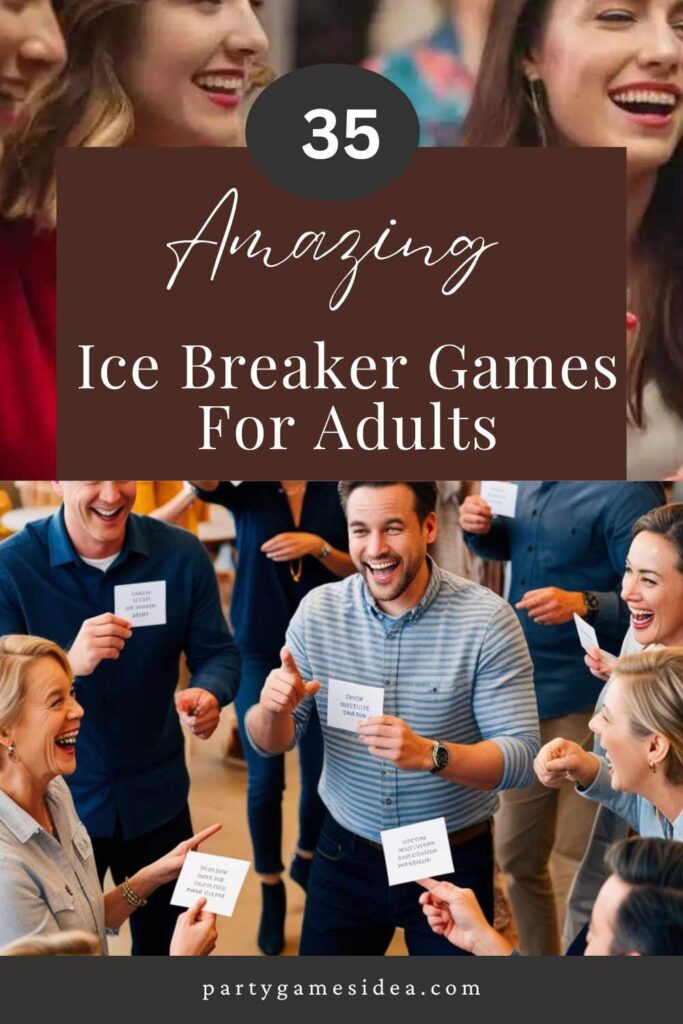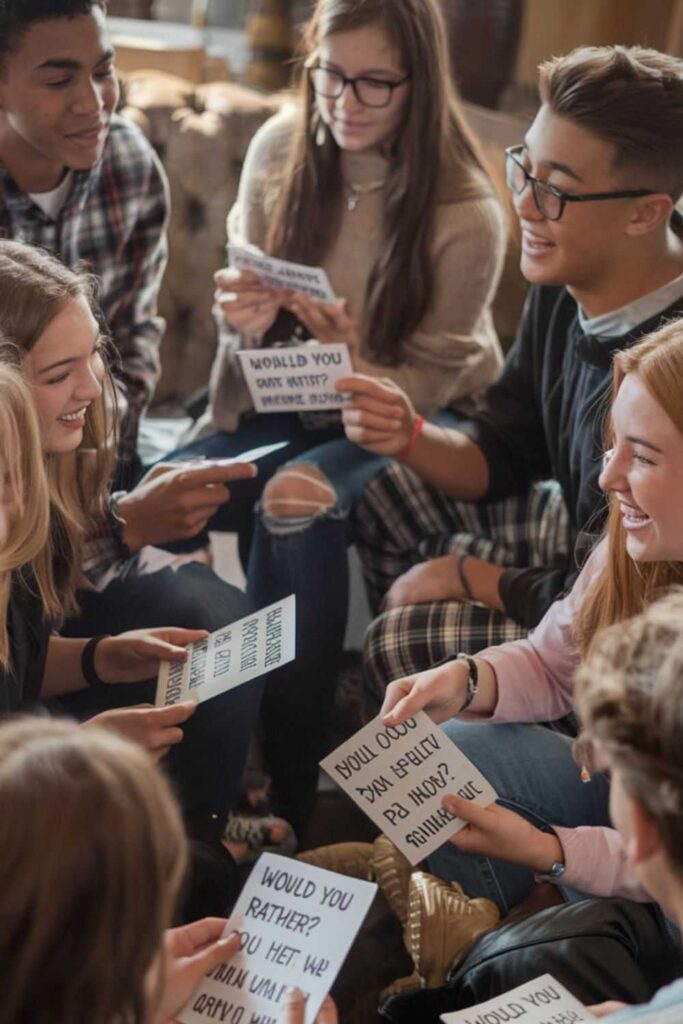Ice Breaker Games For Adults play a crucial role in various social settings by setting the stage for effective communication and interaction. These activities are designed to ease the initial tension that can accompany new or unfamiliar environments, creating a more relaxed atmosphere where participants feel comfortable engaging with one another. By initiating conversations and encouraging interaction, ice breakers help to foster connections between individuals who may not otherwise have interacted, thus promoting a sense of camaraderie and cooperation.
The benefits of ice breaker games extend beyond just making people feel at ease. They are instrumental in enhancing group dynamics by encouraging collaboration, building trust, and breaking down social barriers. In both personal and professional settings, these games serve to create a more cohesive and inclusive environment, which can lead to more productive and enjoyable interactions.
Ice Breaker Games For Adults
Ice breaker games for adults are engaging activities designed to help people get to know each other in a fun and relaxed way. These games are perfect for breaking down barriers, encouraging conversation, and creating a comfortable atmosphere in social or professional settings. Whether it’s at a team-building event, a party, or a workshop, ice breaker games can spark connections, ease tension, and set the stage for a more enjoyable and productive gathering.
Two Truths and a Lie For Adults
A classic ice breaker that encourages participants to share personal information in a fun way. Each person states two truths and one lie about themselves, and the rest of the group guesses which statement is the lie.
- Rules:
- Each participant takes a turn sharing three statements: two true and one false.
- The rest of the group tries to identify which statement is the lie.
- After guesses are made, the truth is revealed.
- Tips:
- Choose interesting or unusual facts to make it more engaging.
- Keep the lies believable to make guessing more challenging.
Human Knot Game
This team-building game involves participants standing in a circle and tangling themselves into a human knot. The goal is to untangle without breaking hands.
- Rules:
- Participants stand in a circle and each person grabs hands with two different people across the circle.
- The group works together to untangle the knot without letting go of each other’s hands.
- The game is complete when everyone is untangled and standing in a circle.
- Tips:
- Encourage clear communication and teamwork.
- Be mindful of physical limitations and ensure everyone is comfortable.
Find Someone Who
This game encourages participants to mingle and learn interesting facts about each other. Each person must find others who meet specific criteria listed on a sheet or board.
- Rules:
- Provide participants with a list of criteria (e.g., “Find someone who has traveled to Asia”).
- Participants must find individuals who meet these criteria and mark them off.
- The first person to complete their list or the one with the most completed criteria wins.
- Tips:
- Make the criteria diverse and engaging to spark interesting conversations.
- Set a time limit to keep the game dynamic and fast-paced.
Adults Would You Rather?
A fun game that prompts participants to choose between two different scenarios. It’s a great way to reveal preferences and spark conversations.
- Rules:
- Pose a series of “Would you rather” questions to the group.
- Each participant must choose one of the two options and explain their choice.
- There’s no right or wrong answer; it’s about sharing opinions.
- Tips:
- Choose questions that are thought-provoking or humorous to keep the conversation lively.
- Encourage participants to elaborate on their choices for more engaging discussions.
The Desert Island Scenario
In this imaginative game, participants choose which items they would bring if stranded on a desert island. It’s a great way to learn about each other’s priorities and problem-solving skills.
- Rules:
- Pose a scenario where participants are stranded on a desert island.
- Each person must choose three items they would bring and explain why.
- Allow time for everyone to share their choices and reasons.
- Tips:
- Make sure the items chosen are diverse to spark interesting discussions.
- Encourage creativity and thoughtful reasoning behind each choice.
20 Questions Game
This guessing game involves one person thinking of an object, and the others asking up to 20 yes-or-no questions to figure out what it is.
- Rules:
- One person thinks of an object, person, or place.
- The rest of the group takes turns asking yes-or-no questions.
- The game ends when someone guesses correctly or 20 questions have been asked.
- Tips:
- Choose a topic that’s familiar to everyone to make guessing easier.
- Encourage participants to ask broad questions initially to narrow down possibilities.
Escape Room Challenges
Participants work in teams to solve puzzles and complete tasks within a set time to “escape” a themed room. This game promotes teamwork and problem-solving.
- Rules:
- Teams are given a series of puzzles or clues related to a theme.
- They must solve these to unlock the next clue or escape from the room.
- Complete the challenge within the given time to win.
- Tips:
- Choose a theme that suits the group’s interests for added fun.
- Ensure the puzzles are challenging but solvable to keep the game engaging.
Adults Scavenger Hunt
This activity involves finding specific items or completing tasks based on clues. It’s a great way to get people moving and interacting.
- Rules:
- Create a list of items to find or tasks to complete.
- Provide clues or descriptions to guide participants.
- The first team or individual to find all items or complete tasks wins.
- Tips:
- Make sure the clues are clear and not too difficult.
- Incorporate a variety of tasks to keep the hunt interesting.
Trivia Quiz
A fun game where participants answer questions on various topics. It’s a great way to test knowledge and spark friendly competition.
- Rules:
- Prepare a list of trivia questions on different topics.
- Divide participants into teams or have them answer individually.
- Award points for correct answers and tally scores to determine the winner.
- Tips:
- Include a mix of question difficulties to engage everyone.
- Keep the quiz format fun and light-hearted to maintain interest.
Creative Introductions
Participants introduce themselves in a unique or creative way, such as using a personal object or telling a funny story. This game helps break the ice and get people talking.
- Rules:
- Each participant finds a creative way to introduce themselves.
- This could involve sharing an object, telling a story, or performing a quick activity.
- Encourage everyone to participate and be creative.
- Tips:
- Offer examples or prompts to help spark ideas.
- Keep introductions brief to allow everyone a chance to participate.
Storytelling Circle
In this collaborative game, participants create a story together, with each person adding a sentence or phrase. It’s a fun way to build creativity and teamwork.
- Rules:
- One person starts by saying a sentence to begin the story.
- Each participant adds a sentence or phrase in turn to continue the story.
- The game ends when everyone has contributed or the story reaches a natural conclusion.
- Tips:
- Encourage creativity and humor in storytelling.
- Ensure everyone has an opportunity to contribute to keep the game inclusive.
Pictionary
A drawing game where participants sketch clues for others to guess. It’s a fun and interactive way to spark laughter and creativity.
- Rules:
- Participants take turns drawing a word or phrase while others guess what it is.
- Set a time limit for each drawing round.
- Points are awarded for correct guesses.
- Tips:
- Choose words or phrases that are easily drawable.
- Make sure everyone understands the rules of drawing and guessing.
Charades
A classic game where participants act out a word or phrase without speaking, while others try to guess what it is. It’s a lively game that encourages physical expression.
- Rules:
- One person acts out a word or phrase without using words.
- The rest of the group guesses what is being acted out.
- Points are awarded for correct guesses and successful performances.
- Tips:
- Choose a mix of easy and challenging words or phrases.
- Encourage creative and exaggerated acting for added fun.
Ice Breaker Bingo
This game combines bingo with personal interactions. Participants fill out bingo cards with facts about others and try to get bingo by finding people who match those facts.
- Rules:
- Create bingo cards with various personal facts or traits.
- Participants mingle and find others who match the facts on their cards.
- The first to complete a row or the entire card wins.
- Tips:
- Make sure the facts are diverse and interesting to encourage conversation.
- Set a time limit to keep the game energetic.
Guess the Year
Participants guess the year associated with various events or items. It’s a fun way to test historical knowledge and spark discussions.
- Rules:
- Prepare a list of events, items, or pop culture references with associated years.
- Participants guess the year for each item.
- Correct guesses earn points.
- Tips:
- Include a range of years and topics to engage everyone.
- Provide hints if needed to keep the game enjoyable.
Who Am I?
Each participant wears a sticky note with a name or title on their forehead and must guess who they are based on yes-or-no questions from others.
- Rules:
- Place a sticky note with a name or title on each person’s forehead.
- Participants ask yes-or-no questions to figure out their identity.
- The game ends when everyone has guessed their identity.
- Tips:
- Choose names or titles that are well-known to the group.
- Ensure participants are comfortable with the guessing process.
Mingle, Mingle, Stop
A dynamic ice breaker where participants mingle while music plays. When the music stops, they must form a group based on a given criteria.
- Rules:
- Participants walk around and mingle while music plays.
- When the music stops, a criteria (e.g., “find someone with the same birthday month”) is announced.
- Participants form groups based on the criteria.
- Tips:
- Choose criteria that are easy to identify and relate to.
- Use upbeat music to keep the energy high.
Themed Costume Contest
Participants dress up according to a specific theme and showcase their costumes. This game adds a fun and creative element to the ice breaking process.
- Rules:
- Announce a theme for the costumes (e.g., “Superheroes”).
- Participants dress up according to the theme and present their costumes.
- Awards or prizes can be given for creativity, humor, or originality.
- Tips:
- Choose a theme that is inclusive and fun for everyone.
- Encourage creativity and personal expression in costume choices.
Speed Networking
A fast-paced activity where participants rotate and have brief conversations with multiple people, aiming to make connections quickly.
- Rules:
- Set a timer for short intervals (e.g., 3 minutes).
- Participants rotate and have brief conversations with each person they meet.
- After each interval, participants move to the next person.
- Tips:
- Provide conversation prompts to help initiate discussions.
- Keep the pace quick to maintain energy and engagement.
Team Trivia
Teams compete against each other in a trivia contest, answering questions on various topics. It’s a great way to encourage teamwork and friendly competition.
- Rules:
- Divide participants into teams.
- Ask trivia questions on different topics and keep track of scores.
- The team with the most correct answers wins.
- Tips:
- Include a variety of topics to appeal to different interests.
- Encourage team discussion and strategy to answer questions.
Talent Show
Participants showcase their unique talents or skills in a mini talent show. It’s a fun way to highlight individual abilities and entertain the group.
- Rules:
- Each participant has a few minutes to perform or display their talent.
- Encourage a range of talents, from singing to magic tricks.
- Allow the group to cheer and support each performer.
- Tips:
- Create a supportive and encouraging environment for performers.
- Ensure everyone has a chance to participate and showcase their talent.
Memory Lane
A game where participants share a memorable experience based on a given theme, such as “best vacation” or “funniest moment.” It’s a great way to get to know each other.
- Rules:
- Announce a theme for the shared memories.
- Each participant takes turns sharing a memory related to the theme.
- Encourage storytelling and active listening.
- Tips:
- Choose themes that are meaningful and engaging for the group.
- Create a comfortable environment for sharing personal stories.
Compliment Circle
Participants sit in a circle and give genuine compliments to the person on their right. It’s a positive and uplifting way to break the ice.
- Rules:
- Participants form a circle.
- Each person gives a sincere compliment to the person on their right.
- Continue around the circle until everyone has received and given compliments.
- Tips:
- Encourage specific and thoughtful compliments to make them more meaningful.
- Create a positive and supportive atmosphere for sharing.
Guess That Sound
Participants listen to various sounds and try to guess what they are. It’s a fun game that stimulates the senses and prompts discussion.
- Rules:
- Play different sound clips or recordings for the group.
- Participants guess what each sound is.
- Correct guesses earn points or recognition.
- Tips:
- Choose sounds that are distinctive but not too obscure.
- Make sure the sound quality is clear for accurate guessing.
Name That Tune
A music game where participants listen to short clips of songs and try to identify the song title or artist. It’s a fun way to engage with music and test knowledge.
- Rules:
- Play short clips of popular songs for the group.
- Participants guess the title or artist of each song.
- Points are awarded for correct answers.
- Tips:
- Choose a mix of music genres and eras to appeal to different tastes.
- Keep the clips short and the game lively.
Would You Rather (Extreme Edition)
An advanced version of “Would You Rather” with more challenging and thought-provoking scenarios. It’s a great way to spark deeper conversations.
- Rules:
- Pose extreme or unusual “Would you rather” questions to the group.
- Each participant chooses one option and explains their choice.
- Encourage thoughtful discussion and debate.
- Tips:
- Choose scenarios that are intriguing and stimulate conversation.
- Ensure questions are appropriate for the group’s comfort level.
Who’s Most Likely To?
Participants answer questions about who in the group is most likely to do something, like “Who’s most likely to travel the world?” It’s a fun way to learn about each other’s perceptions.
- Rules:
- Ask questions about who in the group is most likely to perform certain actions.
- Participants vote or discuss who they think fits each description.
- Reveal and discuss the most common answers.
- Tips:
- Keep the questions light-hearted and fun.
- Encourage honest and humorous responses.
Secret Talent Reveal
Participants secretly write down a unique talent they have, and others guess who has which talent. It’s a great way to discover hidden skills and interests.
- Rules:
- Each participant writes down a secret talent on a slip of paper.
- Collect and read the talents aloud, and participants guess who each talent belongs to.
- Reveal the person associated with each talent.
- Tips:
- Choose talents that are interesting and varied.
- Keep the game relaxed and enjoyable, focusing on fun discoveries.
Match the Fact
Participants match interesting or unusual facts to the person they believe is associated with each fact. It’s a fun way to learn unique details about each other.
- Rules:
- Collect unique or interesting facts from each participant beforehand.
- Read out the facts and have participants guess which fact belongs to which person.
- Reveal the correct matches and discuss.
- Tips:
- Ensure facts are intriguing and not too personal.
- Use this game to prompt further conversation and learning.
Speed Charades
A fast-paced version of charades where participants have only a few seconds to act out a word or phrase. It’s a high-energy game that promotes quick thinking and laughter.
- Rules:
- Participants take turns acting out a word or phrase with a very short time limit.
- The rest of the group guesses what is being acted out.
- Points are awarded for quick and accurate guesses.
- Tips:
- Choose simple and recognizable words or phrases.
- Keep the time limits short to maintain the game’s speed and excitement.
The Compliment Game
Participants exchange compliments based on given prompts. It’s a positive and interactive way to make everyone feel appreciated.
- Rules:
- Provide prompts or themes for compliments (e.g., “Compliment someone’s creativity”).
- Participants give compliments based on the prompts to different people.
- Ensure everyone receives and gives compliments.
- Tips:
- Choose prompts that encourage thoughtful and genuine compliments.
- Create a supportive atmosphere to enhance the positive impact.
These Ice Breaker Games For Adults are designed to engage participants, foster connections, and make social interactions more enjoyable. Whether you’re at a team-building event, social gathering, networking session, or workshop, these activities can help break the ice and create a lively and inclusive environment.
Adapting Ice Breakers for Different Settings

Hi, I’m Hailey Say, the proud mom and owner of PartyGamesIdea.com. As a dedicated party designer and an expert in party ideas, I have a deep passion for crafting memorable and enjoyable experiences for every occasion. From holiday games to baby showers, bridal showers, bachelor parties, group gatherings, and more, I specialize in creating unique and fun party ideas that cater to all age groups and interests.
With an extensive collection of ideas ranging from printable games, teen and adult games, kids’ party activities, birthday party games, girls’ games, memory games, family games, and outdoor games, I aim to make every event special. My expertise also extends to themed parties such as dinner parties, brunch parties, graduation celebrations, college parties, and fun night games.
On PartyGamesIdea.com, I share my passion and creativity, helping people turn their party visions into reality. With years of experience and a keen eye for detail, I am committed to making your event planning process enjoyable and stress-free. Join me on PartyGamesIdea.com, and together, we’ll create unforgettable memories for you and your loved ones.











